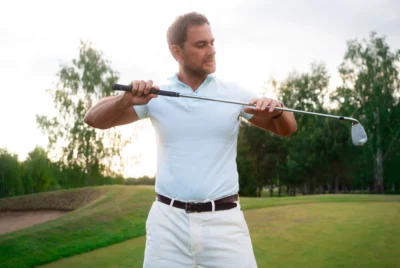Eye Swing and Biomechanics in golf: Understanding the Science Behind Every Movement

The science behind performance
Golf may appear to be a sport of rhythm and instinct, but behind every powerful and precise swing lies a complex system of biomechanics — the science of human movement. Understanding how the body moves, rotates, and transfers energy during the swing is essential to improving consistency and preventing injury.
At Eye Swing, biomechanics is not just a background concept — it’s at the core of the technology. The platform uses advanced motion tracking, artificial intelligence, and data analytics to break down every phase of the swing into measurable movements. The result is a complete scientific interpretation of performance, providing golfers and coaches with accurate insights that lead to lasting improvement.
What are biomechanics in golf
Biomechanics studies how the muscles, joints, and bones work together to produce movement. In golf, this means analyzing how the golfer generates force, maintains posture, and transfers energy from the ground through the body to the club and finally to the ball.
A well-coordinated swing requires efficiency across three main components:
- Kinematic sequence – The correct order and timing of body segments from the lower body up to the hands.
- Rotation and stability – How the hips, spine, and shoulders rotate while maintaining balance and control.
- Force generation – How energy is built from the ground up and released through impact.
Even small inefficiencies in any of these elements can lead to inconsistent shots, loss of power, or physical strain. Eye Swing bridges that gap between human perception and scientific precision, showing exactly where improvements can be made.
How Eye Swing translates biomechanics into real data

Traditional golf instruction has long relied on visual feedback and personal perception. While experienced coaches can identify many technical flaws, the naked eye cannot measure timing, angular velocity, or energy transfer. This is where Eye Swing introduces a technological advantage.
Through motion capture technology and AI-based analysis, Eye Swing tracks body movements frame by frame, translating them into quantifiable data. Coaches and players can visualize:
- Hip and shoulder rotation angles
- Club path and swing plane
- Weight shift and balance points
- Speed and acceleration at impact
This data is then displayed through intuitive graphics and side-by-side comparisons that make complex biomechanics accessible to everyone — from elite coaches to amateur golfers.
The system doesn’t just identify problems; it shows cause and effect. For example, a lack of lower body rotation might be causing an over-the-top move, or an early hip extension might be reducing power at impact. With this understanding, training becomes more targeted and efficient.
Preventing injuries through biomechanical precision
One of the greatest benefits of biomechanical analysis is its role in injury prevention. Many common golf injuries — especially in the lower back, shoulders, and wrists — stem from repetitive motion and poor mechanical habits.
By understanding the body’s movement patterns, Eye Swing helps players identify risky compensations before they become chronic issues. For example:
- Excessive lateral movement can strain the lower spine.
- Limited hip mobility can overload the shoulders.
- Incorrect sequencing can create undue tension in the wrists and forearms.
With data-driven feedback, golfers can adjust their swing to protect their bodies while maintaining power and control. Coaches, in turn, gain a clearer picture of each player’s physical limitations and can adapt training plans accordingly.
Biomechanics for coaches: A new era of teaching
Eye Swing is not just a tool for players — it’s a revolution for golf coaches. By integrating biomechanics into daily instruction, coaches can base their teaching on objective data rather than visual estimation.
This means lessons are no longer about guessing or intuition, but about precise, measurable progress. Coaches can track a player’s swing evolution over time, compare data sessions, and set realistic, scientific performance goals.
In professional academies, this approach builds trust and efficiency. When players see their improvements represented in clear metrics — such as increased rotation speed or better weight transfer — motivation grows, and results become tangible.
The Eye Swing advantage: Where technology meets human understanding

What makes Eye Swing unique is how it blends technology with human insight. The system doesn’t aim to replace the coach but to empower them with deeper knowledge. It transforms subjective observation into objective evaluation.
Beyond simple video analysis, Eye Swing provides a multi-dimensional perspective:
- Biomechanical data for precision.
- AI-driven insights for pattern recognition.
- Visual feedback for immediate understanding.
Together, these tools form a comprehensive ecosystem that enhances learning and accelerates performance improvement.
The future of golf training is scientific
As golf continues to evolve, data and science are redefining how players train. Biomechanics, once reserved for professional laboratories, is now available to every golfer through technologies like Eye Swing.
This democratization of performance analysis represents a new era — one where science and sport merge to create smarter, healthier, and more efficient players. Eye Swing embodies that future, offering not just information but transformation.
Golf is no longer just about repetition; it’s about understanding. And with Eye Swing, every movement tells a story — one that can be measured, improved, and perfected through the science of biomechanics.




